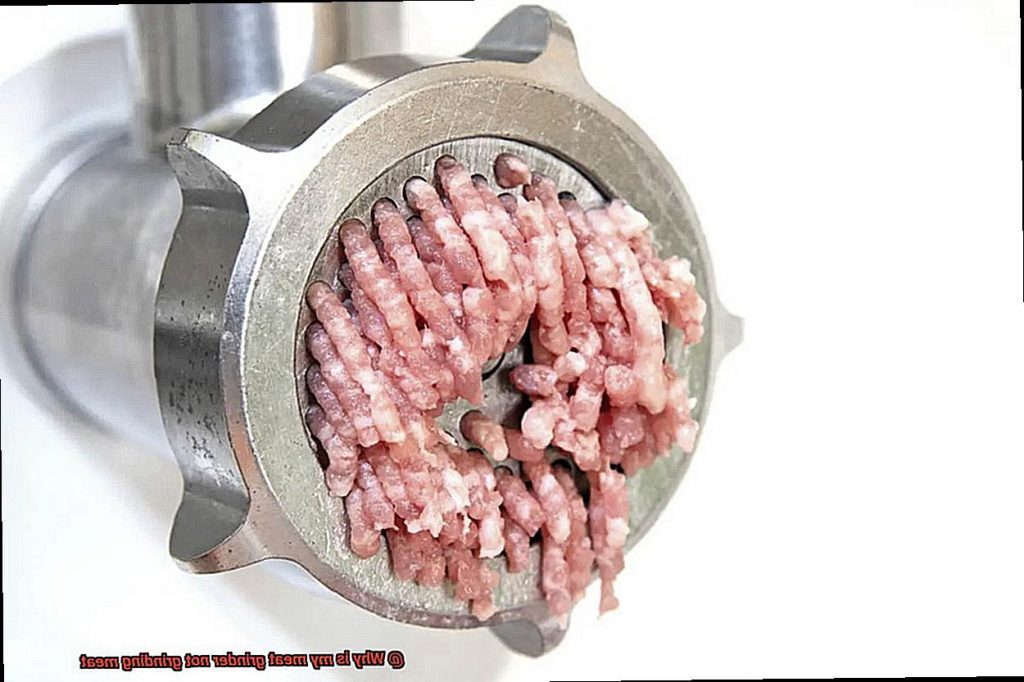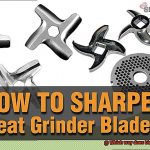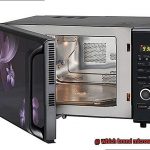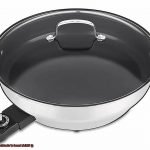Do you find yourself frustrated with your meat grinder’s inability to perform its primary function – grinding meat? It can be a real downer when you’re ready to cook up a storm, but your trusty grinder won’t cooperate. So why is it not grinding meat, even with all your efforts?
Unfortunately, the answer isn’t always straightforward, as there are several possible reasons for this problem. Perhaps the blades have become dull or clogged with tough meat fibers, making it difficult to grind the meat. Maybe some of the components have rusted due to improper cleaning techniques or moisture exposure. Or it could simply be an error in the assembling process that’s causing the grinder to malfunction.
Regardless of the cause, a faulty meat grinder can be a major headache for any home cook. But don’t worry; there’s still hope. By following some useful tips and troubleshooting methods, you can get your grinder back on track and have it grinding meat like a pro again in no time.
In this post, we’ll explore some of the most common reasons why your meat grinder may not be working correctly and provide practical solutions to fix them. So let’s dive right in and get that grinder up and running again.
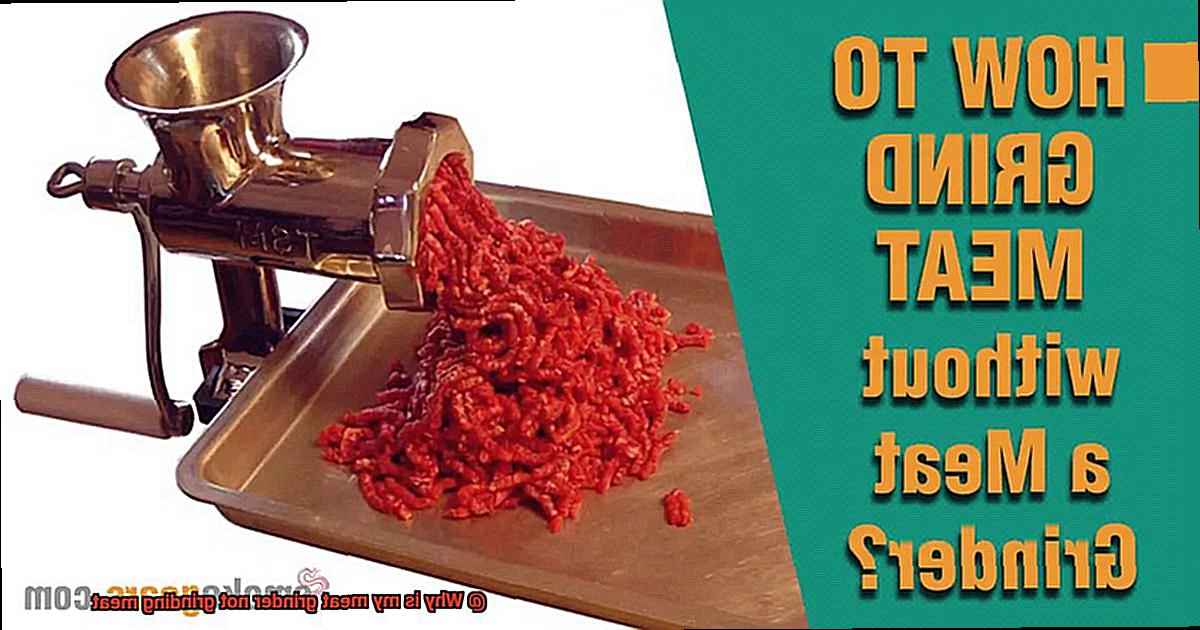
Contents
What is a Meat Grinder?
Store-bought ground meat can be filled with additives and preservatives, but with a meat grinder, you can take control of the quality of your meat.
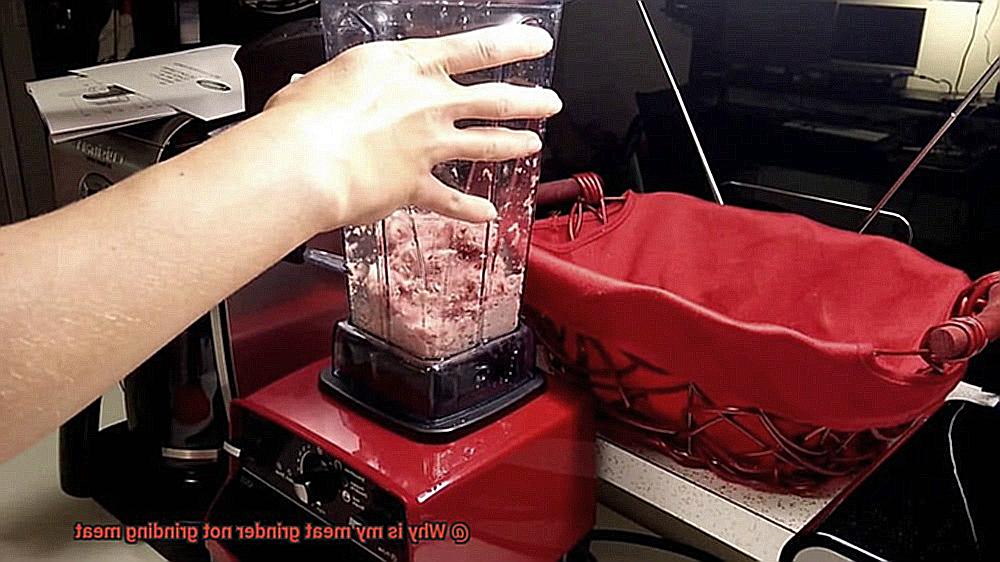
A meat grinder is a kitchen appliance that grinds meat into smaller pieces for cooking or preservation purposes. It’s made up of several parts, including a hopper for the meat, a feed screw to push the meat towards the blade and grinding plate, and the blade and grinding plate itself. As the meat passes through these parts, it’s broken down into smaller, uniform pieces.
Meat grinders come in different sizes and designs, from manual to electric models. Electric models are more efficient and faster than manual ones, making them an excellent choice for larger quantities of meat. Additionally, different models are designed for specific types of meat, such as beef, pork, chicken, or fish.
Owning a meat grinder allows you to control the quality of your meat. You can choose which cuts of meat to use and ensure that there are no unwanted additives or preservatives. Plus, it’s perfect for home cooks who want to make their own sausages or burgers and hunters who want to process their game meat.
However, like any other kitchen appliance, a meat grinder requires proper care and maintenance to work efficiently. Dull blades, clogs, and improper assembly can cause your grinder to malfunction and not grind your meat correctly. Here are some tips for maintaining your machine:
- Regularly sharpen your blades or replace them when necessary
- Cut your meat into small pieces before feeding it into the hopper
- Follow the manufacturer’s instructions carefully when assembling your grinder
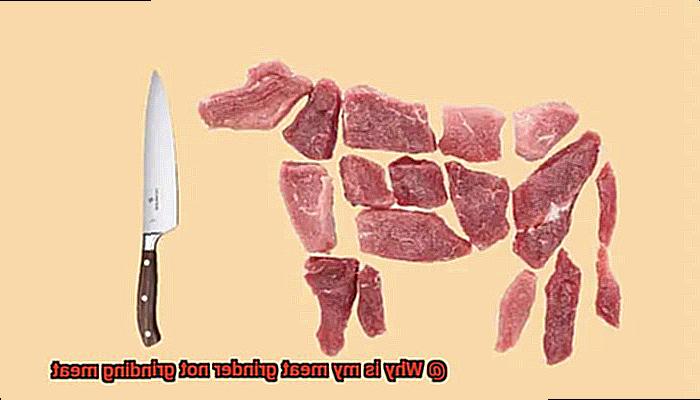
Reasons Why Your Meat Grinder May Not Be Grinding Meat Properly
There are several reasons why your meat grinder may not be performing as it should. Let’s take a closer look at five common reasons and explore how to fix them.
Dull Blades:
One of the most common reasons for a meat grinder not grinding meat is dull blades. A blunt blade can result in unevenly ground meat or meat that is not ground at all. To combat this problem, it is important to regularly sharpen or replace your grinder blades.
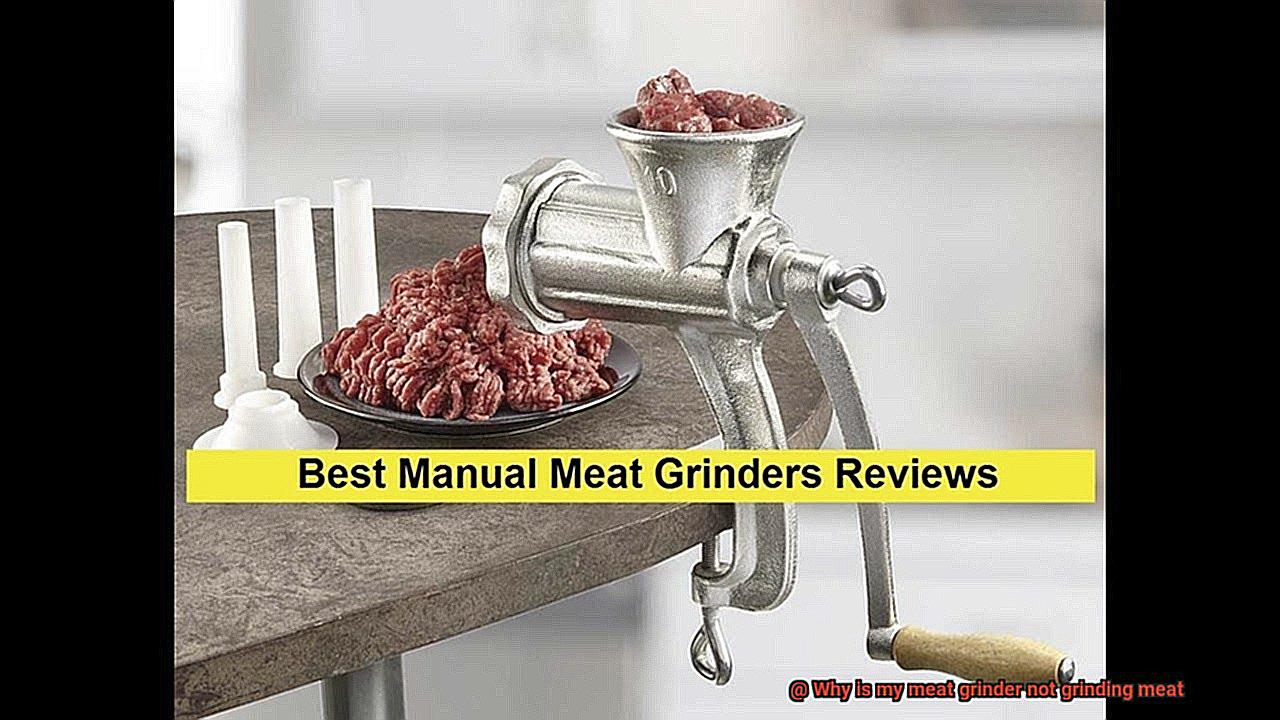
Clogs:
Bits of sinew or gristle can get stuck in the grinder’s parts, preventing the meat from being ground properly. Overloading the machine can also cause clogs. To avoid this, cut your meat into small pieces before feeding it into the grinder and avoid overloading the machine.
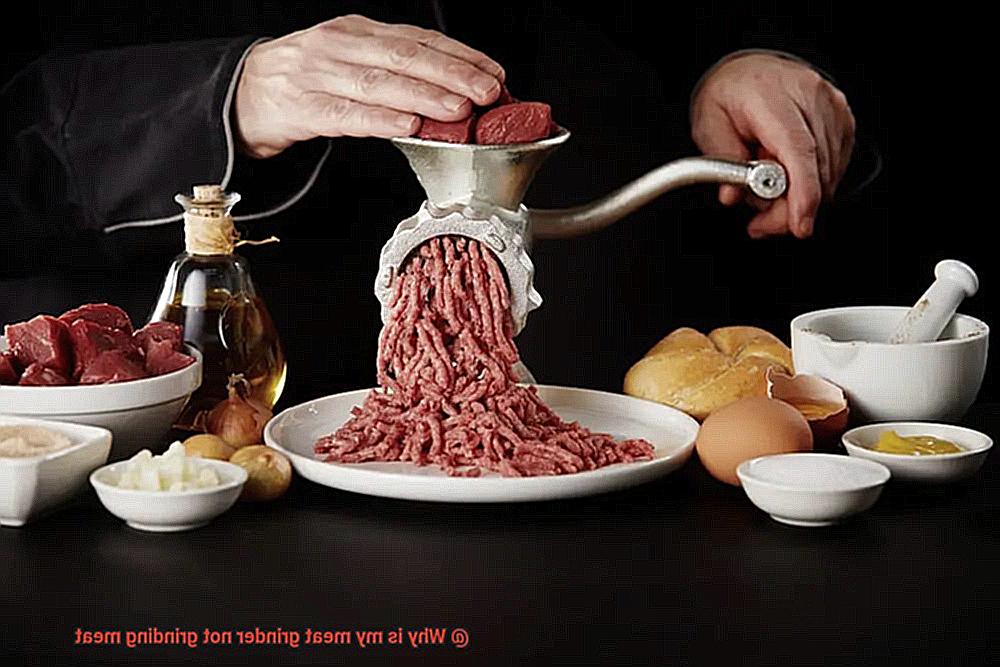
Improper Assembly:
If the parts of your grinder are not assembled correctly, it can cause the machine to malfunction. Ensure that you follow the manufacturer’s instructions carefully when assembling your grinder to ensure it works correctly.
Using the Wrong Type of Meat:
Certain meats, like lamb or game meats, can be more challenging for some grinders to handle. Tough cuts of meat or those with gristle and fat may require pre-cutting or trimming before grinding. Cut the meat into small enough pieces that fit through the grinder and avoid overloading it.
Size of Grinder Plate:
The size of your grinder plate can affect how fine your meat is ground. If the plate is too large, it may not grind the meat finely enough. Conversely, if it is too small, it can cause the grinder to clog and prevent it from working properly.
Loose or Worn Out Screw:
If the screw holding the blade in place is loose or damaged, it can cause the blade to wobble and prevent effective grinding. Additionally, a misaligned auger or hopper that is not securely attached to the grinder can cause issues with the grinding process.
Dull Blades
Perhaps it’s taking ages to grind your meat or not grinding it at all. If so, then it is likely that the blades on your machine have become dull. But don’t worry, I’m here to help you understand why maintaining and sharpening the blades of your meat grinder is critical for optimal performance.
Blades that are responsible for cutting and grinding the meat can become dull over time due to wear and tear or improper maintenance. Dull blades are a common cause of a meat grinder not grinding meat properly. However, regular maintenance and sharpening are necessary to keep the blades in good condition.
To prevent dullness, ensure that you clean the blades after each use and sharpen them regularly using a sharpening stone or professional sharpening service. Proper lubrication is also essential before using the blades to grind meat, as it helps prevent rusting.
But what if you’ve neglected your blades for too long and they’re beyond repair? In such cases, you may need to replace them entirely. When purchasing replacement blades, ensure that they are from the same manufacturer as your meat grinder for compatibility and optimal performance.
Clogs
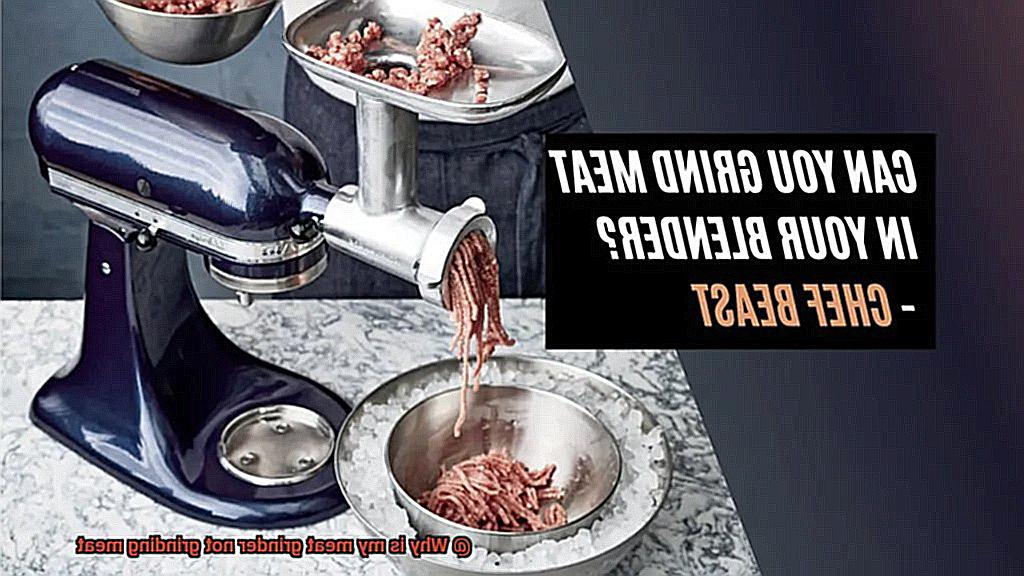
Preventing clogs is all about proper preparation. To avoid clogs, make sure your meat is at room temperature and cut it into smaller pieces before feeding it into the grinder. This will help the meat to pass through the grinder smoothly without any issues. If you try to grind meat that’s still partially frozen or too large, it can get stuck in the feeding tube or blades, causing a frustrating clog.
Sometimes despite our best efforts, clogs can still occur. In these situations, taking the necessary steps to clear the clog is crucial. Begin by turning off and unplugging the grinder from the wall. Then, disassemble the grinder and remove any pieces of meat or debris that may be causing the clog. Once you’ve cleared away the obstruction, reassemble your grinder and try grinding again.
If you find yourself consistently dealing with clogs despite taking these steps, consider investing in a more powerful or higher-quality meat grinder. Cheaper or lower-quality grinders may be more prone to clogs and other issues, so upgrading could help eliminate these problems altogether.
In addition to proper preparation and maintenance of your machine, there are other things to keep in mind when it comes to preventing clogs. Try using a steady, consistent pressure when feeding meat into the grinder and avoid overloading it. Also, make sure to clean your grinder thoroughly after each use to prevent buildup that can lead to clogs.
Improper Assembly
If so, improper assembly might be the culprit. It’s one of the most common reasons why meat grinders fail to function correctly.
Improper assembly refers to putting the parts of your meat grinder together incorrectly. This can lead to a range of issues, from clogging to overheating and even machine breakdown. Let’s delve deeper into some specific problems that can arise from improper assembly.
One common mistake is failing to attach the cutting blades and plates accurately. The alignment of these parts is crucial for effective grinding. If they’re not attached precisely, the meat will get stuck in the grinder, causing frustration and a big mess. A dull blade will only make matters worse by causing more clogs and jams.
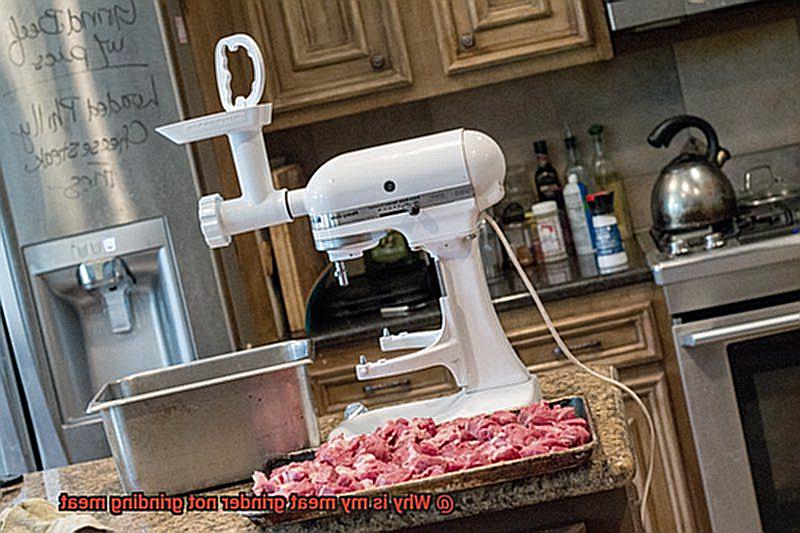
Another issue stemming from improper assembly is inadequate lubrication. When the parts of your meat grinder aren’t lubricated correctly, friction can occur between them. This leads to overheating and eventual machine breakdown, a nightmare for any home cook or professional chef.
To avoid these frustrating issues, take the time to assemble your meat grinder correctly. Ensure that all parts are aligned accurately and lubricated adequately before use. By doing so, you’ll avoid clogging or jamming and prolong your machine’s life.
How to Prevent Dull Blades and Clogs
If you’re a meat grinder user, you know how frustrating it can be when your grinder isn’t working as well as it should. The two most common issues are dull blades and clogs. Luckily, there are easy ways to prevent these problems and keep your grinder in top shape.
Sharpen your blades regularly
Dull blades can make the grinding process slow and uneven. To avoid this, sharpen your blades after every use or at least once a month if you grind frequently. Use a sharpening stone or attachment to keep the blades sharp. It’s also recommended to avoid grinding bones or other hard materials that can damage the blades.
Prepare your meat properly
Clogs occur when pieces of meat or fat get stuck in the grinder’s internal parts, causing it to jam. To prevent this, trim off any excess fat and cut the meat into small pieces that can easily fit into the grinder’s feeding tube. Opt for high-quality meat that is leaner and easier to grind.
Properly assemble and maintain your grinder
Incorrect assembly can cause your grinder to malfunction. It’s essential to read and follow the manufacturer’s instructions carefully when assembling your grinder. After each use, clean the grinder thoroughly to remove any remaining meat particles that can cause clogs.
Use a dedicated bone grinder attachment
If you need to grind bones, it’s recommended to use a dedicated bone grinder attachment that’s specifically designed for this purpose. This will prevent damage to the blades and help them last longer.
Invest in a high-quality meat grinder
Finally, investing in a high-quality meat grinder can also help prevent dull blades and clogs. Cheap or poorly made grinders often have weaker motors and dull blades that wear out quickly. A high-quality meat grinder will last longer and provide better results.
Tips for Proper Assembly
Assembling a meat grinder may seem like a straightforward task, but it is crucial to do it right to ensure that the machine works efficiently. Here are some essential tips for proper assembly that will help you use your meat grinder without any hassle.
To start with, always read the manufacturer’s instructions carefully. These instructions will guide you on how to assemble the machine correctly and safely. It is essential to follow these instructions to avoid any damage or injury to yourself.
Another critical tip is to clean and dry all parts before assembly. Any leftover debris or moisture can cause the machine to malfunction, resulting in improper grinding of meat. Therefore, it is vital to clean and dry all parts thoroughly before assembling.
Furthermore, ensuring that all parts fit correctly is crucial. Any looseness or improper fit can cause the machine to vibrate or not grind meat properly. Therefore, make sure all parts are securely in place and tightened according to the manufacturer’s instructions.
Lubrication of all moving parts with food-grade lubricant before use is also a vital tip for proper assembly. Lubrication helps reduce friction between moving parts and prevent wear and tear on the machine. This will also help your machine last longer and work efficiently.
Lastly, before starting the machine, make sure all safety features are engaged. These features protect both you and the machine from any potential harm or damage. Always check if the safety lock or overload protection is engaged before switching on the machine.
Conclusion
In conclusion, a meat grinder is an indispensable tool for anyone who values quality and control in their meat preparation. However, like any machine, it requires proper care and maintenance to function at its best. Dull blades, clogs, improper assembly, using the wrong type of meat, and incorrect plate size are all common culprits when your meat grinder refuses to do its job.
But don’t despair. There are several steps you can take to get your grinder back on track. First and foremost, make sure that your blades are sharp enough to slice through even the toughest cuts of meat. Additionally, always prepare your meat properly before feeding it into the grinder – this means removing any bones or gristle that could cause clogs or damage to the machine.
Proper assembly is also key – take the time to carefully read the manufacturer’s instructions and ensure that all parts fit securely and are lubricated with food-grade lubricants before use. And don’t forget about safety features such as overload protection and safety locks.
By following these tips and troubleshooting methods outlined in this post, you’ll be well on your way to enjoying perfectly ground meat every time. So keep those blades sharp, check your assembly regularly and invest in a high-quality grinder with a dedicated bone grinder attachment if necessary.

